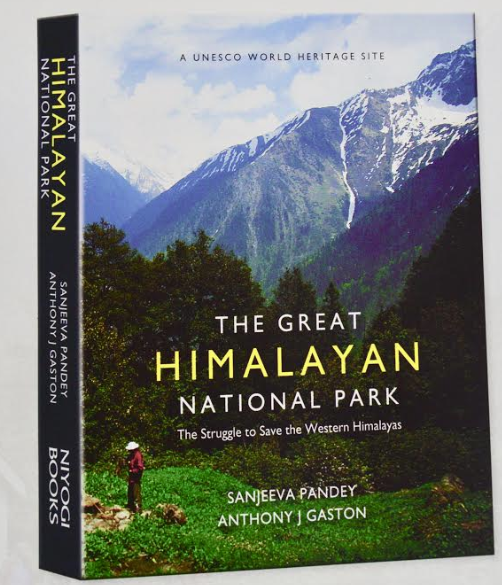Shimla: Being sensitive to temperature variations, mountain ecosystems in the Himalayas are facing severe disruption from global warming as they are witnessing melting glaciers and major ecological and geophysical changes, wildlife biologists say.
The prevention of soil erosion and the preservation of native flora and fauna are increasingly becoming a big challenge, says a book, “The Great Himalayan National Park: The Struggle to Save the Western Himalayas”, written by environmentalist Sanjeeva Pandey and senior Canadian research scientist Anthony (Tony) Gaston.
The 360-page book, priced at Rs 1,500, will be published by the end of 2018.
The unpredictability of weather and natural changes that have struck the Himalayan state of Himachal Pradesh in the past two decades are clear indicators of a marked shift in weather patterns in the region, according to the book.
The state government recognises that climate change is enhancing pressure on the forests, biological diversity and the local environment that are of critical importance, not only for the people of the state but also the plains of northern India, Pandey, who retired as Principal Chief Conservator Forests, told IANS.

He also served as the Director of the Great Himalayan National Park (GHNP) from 1998 to 2006. It falls largely in the Kullu Valley and is a prime hotspot of biological diversity in the western Himalayas.
Gaston has played a crucial role in getting inscription of the GHNP Conservation Area in the Unesco World Heritage List in 2014.
In addition to descriptions of the ecology, the book talks about local history and culture and gives a review of current developments in the region.
The grandeur and diversity of the area is captured in the pictures taken by the authors and their collaborators.
“The book speaks on numerous examples of conservation in action that will motivate a new generation of naturalists and ecologists to continue the fight to protect the ecology of the greatest mountains on earth,” Pandey, who is based in the state capital, said.
The Great Himalayan National Park has a composite of representative habitats over a huge altitudinal range (1,900 to 6,110 m), with more than 46 peaks over 5,000 m altitude.
One of the richest biodiversity sites in the western Himalayas, the GHNP is home to the elusive and critically endangered western tragopan, along with four other spectacular pheasants, besides the snow leopard and the mighty Himalayan brown bear.
A recent study indicated the GHNP offers the best protected habitat for the snow leopard in the context of climate change. But there is existing evidence which shows the treeline in the Himalayas is shifting upwards, say the biologists.
There is a body of research that amply demonstrates the superiority of native vegetation in providing ecosystem services.
The alien species such as lantana, parthinium, wattles, eucalyptus and numerous others can adversely affect the overall functioning of these ecosystems.
The introduction of many of these non-native species has had substantial economic, conservation and societal consequences. The conservation of rare native species can add to the biological insurance of a temperate ecosystem.
Conversely, the extinction of such species can have a cascading effect, resulting in major changes in the plant and animal community. Research also suggests that biodiverse systems can store more carbon than degraded ones.
Quoting the research of British traveller Penelope Chetwode in Kullu area in 20th century, the book says the villages on the western periphery of the GHNP display some of the most intact and indigenous, traditional homes and temples.
The Kath-Kuni style of architecture has evolved through the ages. The dwellings in this style are made in response to local topography and climate.
Deodar (cedar) wood and stone are the main building material and houses of this design have withstood many earthquakes and cloudbursts in the area.
The watermills in the interior areas of GHNP ecozone are wonderful examples of local technology at work, claims the book.
There is excellent blend of modernity and tradition in the GHNP.
The book says with the arrival of modern culture, some of these temples, described lucidly by Penelope in her book, are being painted in colours which are alien to traditional aesthetics.
The nomadic grazers or ‘gaddis’ have added immensely to local taxonomy through their folksongs.
The material manifestation of divinity in the form of ‘mohras’ or images of God in metal is very evident in Kullu district.
The temples, special trees at the base of a long climb, and ‘devbans’ or sacred groves in the villages on the western boundary of the GHNP display ‘mohras’ very prominently.
Some of the ‘mohras’ are made of special metal which can last for many centuries and are considered very valuable.
GHNP authorities say the best sighting of wildlife can be made in autumn (September-November) as animals start their seasonal migration to lower altitudes.
Courtesy: IANS
A seasoned journalist with over two decades of experience, Vishal writes on a wide range of subjects which include biodiversity, climate change and links between environment & development. He also covers politics and other developments in Punjab and Himachal Pradesh. He lives in Chandigarh & Shimla.


